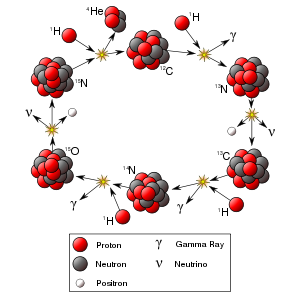CNO cycle

The CNO cycle (for carbon-nitrogen-oxygen), or sometimes Bethe-Weizsäcker-cycle, is one of two sets of fusion reactions by which stars convert hydrogen to helium, the other being the proton-proton chain. Theoretical models show that the CNO cycle is the dominant source of energy in stars more massive than about 1.3 times the mass of the sun. The proton-proton chain is more important in stars the mass of the sun or less. This difference stems from temperature dependency differences between the two reactions; pp-chain reactions start occurring at temperatures around 4×106 K, making it the dominant force in smaller stars. The CNO chain starts occurring at approximately 13×106 K, but its energy output rises much faster with increasing temperatures. At approximately 17×106 K, the CNO cycle starts becoming the dominant source of energy.[1] The Sun has a core temperature of around 15.7×106 K and only 1.7% of 4He nuclei being produced in the Sun are born in the CNO cycle. The CNO process was independently proposed by Carl von Weizsäcker[2] and Hans Bethe[3] in 1938 and 1939, respectively.
In the CNO cycle, four protons fuse, using carbon, nitrogen and oxygen isotopes as a catalyst, to produce one alpha particle, two positrons and two electron neutrinos. The positrons will almost instantly annihilate with electrons, releasing energy in the form of gamma rays. The neutrinos escape from the star carrying away some energy. The carbon, nitrogen, and oxygen isotopes are in effect one nucleus that goes through a number of transformations in an endless loop.
Contents |
CNO-I
The main reactions of the CNO cycle are 126C→137N→136C→147N→158O→157N→126C:[4]
-
126C + 11H → 137N + γ + 1.95 MeV 137N → 136C + e+ + νe + 2.22 MeV 136C + 11H → 147N + γ + 7.54 MeV 147N + 11H → 158O + γ + 7.35 MeV 158O → 157N + e+ + νe + 2.75 MeV 157N + 11H → 126C + 42He + 4.96 MeV
where the Carbon-12 nucleus used in the first reaction is regenerated in the last reaction.
CNO-II
In a minor branch of the reaction, occurring in the Sun's core just 0.04% of the time, the final reaction shown above does not produce carbon-12 and an alpha particle, but instead produces oxygen-16 and a photon and continues 157N→168O→179F→178O→147N→158O→157N:
-
157N + 11H → 168O + γ + 12.13 MeV 168O + 11H → 179F + γ + 0.60 MeV 179F → 178O + e+ + νe + 2.76 MeV 178O + 11H → 147N + 42He + 1.19 MeV 147N + 11H → 158O + γ + 7.35 MeV 158O → 157N + e+ + νe + 2.75 MeV
Like the carbon, nitrogen, and oxygen involved in the main branch, the fluorine produced in the minor branch is merely catalytic and at steady state, does not accumulate in the star.
OF Cycle
This subdominant branch is significant only for massive stars. The reactions are started when one of the reactions in CNO-II results in fluorine-18 and gamma instead of nitrogen-14 and alpha, and continues 178O→189F→188O→199F→168O→179F→178O:
-
178O + 11H → 189F + γ + 5.61 MeV 189F → 188O + e+ + νe + 1.656 MeV 188O + 11H → 199F + γ + 7.994 MeV 199F + 11H → 168O + 42He + 8.114 MeV 168O + 11H → 179F + γ + 0.60 MeV 179F → 178O + e+ + νe + 2.76 MeV
Note that all these cycles have the same net result:
- 4 11H → 42He + 2 e+ + 2 νe + 3 γ + 26.8 MeV
Use in astronomy
While the total number of "catalytic" CNO nuclei is conserved in the cycle, in stellar evolution the relative proportions of the nuclei are altered. When the cycle is run to equilibrium, the ratio of the carbon-12/carbon-13 nuclei is driven to 3.5, and nitrogen-14 becomes the most numerous nucleus, regardless of initial composition. During a star's evolution, convective mixing episodes bring material in which the CNO cycle has operated from the star's interior to the surface, altering the observed composition of the star. Red giant stars are observed to have lower carbon-12/carbon-13 and carbon-12/nitrogen-14 ratios than main sequence stars, which is considered to be convincing evidence for the operation of the CNO cycle.
The presence of the heavier elements carbon, nitrogen and oxygen places an upward bound on the maximum size of massive stars to approximately 150 solar masses. It is thought that the "metal-poor" early universe could have had stars, called Population III stars, up to 250 solar masses without interference from the CNO cycle at the beginning of their lifetime.
See also
External links
- H. A. Bethe: Energy Production in Stars, 1938
- I. Iben: Stellar Evolution Within and off the Main Sequence, 1967
References
- ↑ Schuler, Simon C.; King, Jeremy R.; The, Lih-Sin (August 2009). "Stellar Nucleosynthesis in the Hyades Open Cluster". the Astrophysical Journal 701 (1): 837–849. doi:10.1088/0004-637X/701/1/837. http://arxiv.org/PS_cache/arxiv/pdf/0906/0906.4812v1.pdf.
- ↑ von Weizsäcker, C. F. (1938). "Über Elementumwandlungen in Innern der Sterne II (Element Transformation Inside Stars, II)". Physikalische Zeitschrift 39: 633–46.
- ↑ Bethe, H. A. (1939). "Energy Production in Stars". Physical Review 55 (5): 434–56. doi:10.1103/PhysRev.55.434. http://prola.aps.org/abstract/PR/v55/i5/p434_1.
- ↑ Kenneth S. Krane (1988). Introductory Nuclear Physics. John Wiley & Sons. p. 537. ISBN 0-471-80553-X.
|
||||||||||||||||